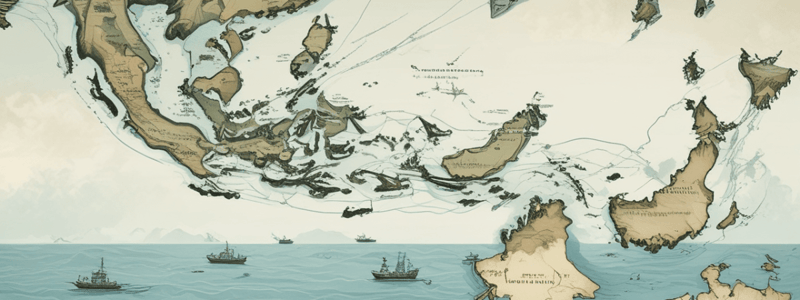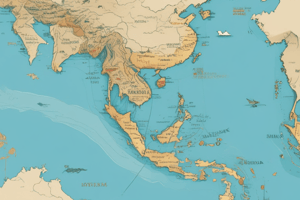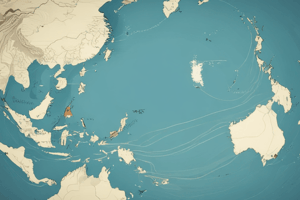Podcast
Questions and Answers
Which international organization was involved in the PRC's attempt to maintain the Khmer Rouge regime's seat?
Which international organization was involved in the PRC's attempt to maintain the Khmer Rouge regime's seat?
- ASEAN
- United Nations (correct)
- European Union
- Non-Aligned Movement
What was the significance of the South China Sea, according to the passage?
What was the significance of the South China Sea, according to the passage?
- It is a major shipping route
- It is a disputed territory between China and Vietnam
- It is reputed to contain large natural gas and oil resources (correct)
- It is a popular tourist destination
What did Vietnam do in response to China's Territorial Waters Law in 1992?
What did Vietnam do in response to China's Territorial Waters Law in 1992?
- Declared its sovereignty over the Paracel and Spratly Islands (correct)
- Protested at the United Nations
- Signed a treaty with China
- Cut off diplomatic ties with China
What incident occurred in May 2011, according to the passage?
What incident occurred in May 2011, according to the passage?
How many states have competing claims in the South China Sea, according to the passage?
How many states have competing claims in the South China Sea, according to the passage?
What was the distance of Vietnam's maritime border proclamation in 1977?
What was the distance of Vietnam's maritime border proclamation in 1977?
Which country dominated the International Bank for Economic Cooperation and the International Investment Bank?
Which country dominated the International Bank for Economic Cooperation and the International Investment Bank?
What event triggered Vietnam's retaliatory bombing raids in 1977?
What event triggered Vietnam's retaliatory bombing raids in 1977?
Which Chinese leader's presidency marked a reversal of the trend of decentralization of power in the CCP?
Which Chinese leader's presidency marked a reversal of the trend of decentralization of power in the CCP?
What was the name of the organization that controlled the International Bank for Economic Cooperation and the International Investment Bank?
What was the name of the organization that controlled the International Bank for Economic Cooperation and the International Investment Bank?
What was the outcome of the Chinese invasion of Vietnam in 1979?
What was the outcome of the Chinese invasion of Vietnam in 1979?
What was the purpose of China’s People’s Liberation Army (PLA) incursion into Vietnam in 1984?
What was the purpose of China’s People’s Liberation Army (PLA) incursion into Vietnam in 1984?
What is the name of the islands in the South China Sea that were the subject of a naval confrontation between China and Vietnam in 1988?
What is the name of the islands in the South China Sea that were the subject of a naval confrontation between China and Vietnam in 1988?
When did China begin to patrol the waters surrounding the disputed Spratly Islands?
When did China begin to patrol the waters surrounding the disputed Spratly Islands?
What has been the nature of the political relationship between China and Vietnam throughout their conflict?
What has been the nature of the political relationship between China and Vietnam throughout their conflict?
What was the outcome of the Battle of Dien Bien Phu?
What was the outcome of the Battle of Dien Bien Phu?
Why did China pressure the Democratic Republic of Vietnam to accept a temporary two-state solution?
Why did China pressure the Democratic Republic of Vietnam to accept a temporary two-state solution?
What was the outcome of the temporary two-state solution implemented in 1954?
What was the outcome of the temporary two-state solution implemented in 1954?
What was China's strategic decision regarding the Khmer Rouge in Kampuchea?
What was China's strategic decision regarding the Khmer Rouge in Kampuchea?
Who was the charismatic leader of the Democratic Republic of Vietnam?
Who was the charismatic leader of the Democratic Republic of Vietnam?
The Standing Committee of the CCP Politburo played a less important role in the decision-making process during the presidency of Xi Jinping.
The Standing Committee of the CCP Politburo played a less important role in the decision-making process during the presidency of Xi Jinping.
Vietnam joined the International Bank for Economic Cooperation and the International Investment Bank in May 1977.
Vietnam joined the International Bank for Economic Cooperation and the International Investment Bank in May 1977.
China's response to Vietnam's enlargement of its maritime border was an immediate attack on Vietnam's border villages.
China's response to Vietnam's enlargement of its maritime border was an immediate attack on Vietnam's border villages.
Xi Jinping's presidency began in 2017.
Xi Jinping's presidency began in 2017.
The International Bank for Economic Cooperation and the International Investment Bank were dominated by the Chinese government.
The International Bank for Economic Cooperation and the International Investment Bank were dominated by the Chinese government.
The Democratic Republic of Vietnam achieved a decisive victory over France’s military forces in the Battle of Dien Bien Phu in 1975.
The Democratic Republic of Vietnam achieved a decisive victory over France’s military forces in the Battle of Dien Bien Phu in 1975.
China supported the Democratic Republic of Vietnam in crushing the Khmer Rouge in Kampuchea.
China supported the Democratic Republic of Vietnam in crushing the Khmer Rouge in Kampuchea.
The People's Republic of China and the Democratic Republic of Vietnam were ideologically kin Communist states.
The People's Republic of China and the Democratic Republic of Vietnam were ideologically kin Communist states.
Ho Chi Minh, the charismatic leader of the Democratic Republic of Vietnam, was pleased with the temporary two-state solution imposed by China in 1954.
Ho Chi Minh, the charismatic leader of the Democratic Republic of Vietnam, was pleased with the temporary two-state solution imposed by China in 1954.
The temporary two-state solution implemented in 1954 lasted for only 2 years.
The temporary two-state solution implemented in 1954 lasted for only 2 years.
Vietnam gained control of Cambodia after the Chinese incursion in 1979.
Vietnam gained control of Cambodia after the Chinese incursion in 1979.
The Chinese forces withdrew from Vietnam after 28 days of fighting.
The Chinese forces withdrew from Vietnam after 28 days of fighting.
The Spratly Islands in the South China Sea are disputed territories claimed only by China and Vietnam.
The Spratly Islands in the South China Sea are disputed territories claimed only by China and Vietnam.
The naval battle between China and Vietnam in 1988 was a low-intensity conflict.
The naval battle between China and Vietnam in 1988 was a low-intensity conflict.
The relationship between China and Vietnam has been peaceful throughout their history.
The relationship between China and Vietnam has been peaceful throughout their history.
Vietnam proclaimed its sovereignty over the Paracel Islands in 1992.
Vietnam proclaimed its sovereignty over the Paracel Islands in 1992.
China's Territorial Waters Law declared sovereignty over the entire South China Sea.
China's Territorial Waters Law declared sovereignty over the entire South China Sea.
The Philippines was not involved in the territorial conflict in the South China Sea.
The Philippines was not involved in the territorial conflict in the South China Sea.
The South China Sea is a region of minimal natural resources.
The South China Sea is a region of minimal natural resources.
Vietnam responded to China's Territorial Waters Law by cutting diplomatic ties in 1992.
Vietnam responded to China's Territorial Waters Law by cutting diplomatic ties in 1992.
What was the reason behind Vietnam's retaliatory bombing raids in 1977?
What was the reason behind Vietnam's retaliatory bombing raids in 1977?
How did the decision-making process in the Chinese Communist Party change during the presidencies of Jiang Zemin and Hu Jintao?
How did the decision-making process in the Chinese Communist Party change during the presidencies of Jiang Zemin and Hu Jintao?
What was the strategic decision made by Vietnam in May 1977, perceived by China as hostile?
What was the strategic decision made by Vietnam in May 1977, perceived by China as hostile?
What international organizations did Vietnam join in May-June 1977, further straining its relations with China?
What international organizations did Vietnam join in May-June 1977, further straining its relations with China?
Which Chinese leader's presidency marked a reversal of the trend of decentralization of power in the CCP?
Which Chinese leader's presidency marked a reversal of the trend of decentralization of power in the CCP?
What was the motivation behind China's declaration of suzerainty over the South China Sea in 1992?
What was the motivation behind China's declaration of suzerainty over the South China Sea in 1992?
What was the outcome of the near-physical clash between China's and the Philippines' patrol boats near the Spratly Islands in 2013?
What was the outcome of the near-physical clash between China's and the Philippines' patrol boats near the Spratly Islands in 2013?
How did Vietnam respond to China's declaration of sovereignty over the South China Sea in 2003?
How did Vietnam respond to China's declaration of sovereignty over the South China Sea in 2003?
What was the significance of the South China Sea in the context of the conflict between China and Vietnam?
What was the significance of the South China Sea in the context of the conflict between China and Vietnam?
What was the nature of the political relationship between China and Vietnam throughout their conflict?
What was the nature of the political relationship between China and Vietnam throughout their conflict?
What was the outcome of the Chinese invasion of Vietnam in 1979?
What was the outcome of the Chinese invasion of Vietnam in 1979?
What is the significance of the Spratly Islands in the South China Sea?
What is the significance of the Spratly Islands in the South China Sea?
What was the nature of the political relationship between China and Vietnam throughout their conflict?
What was the nature of the political relationship between China and Vietnam throughout their conflict?
What was the outcome of the naval battle between China and Vietnam in 1988?
What was the outcome of the naval battle between China and Vietnam in 1988?
How did China's People's Liberation Army (PLA) incursion into Vietnam in 1984 end?
How did China's People's Liberation Army (PLA) incursion into Vietnam in 1984 end?
What was the outcome of the Battle of Dien Bien Phu, and how did it impact the relationship between China and Vietnam?
What was the outcome of the Battle of Dien Bien Phu, and how did it impact the relationship between China and Vietnam?
What was China's strategic decision regarding the Khmer Rouge in Kampuchea, and what were the implications of this decision?
What was China's strategic decision regarding the Khmer Rouge in Kampuchea, and what were the implications of this decision?
What was the nature of the relationship between China and Vietnam throughout their conflict, and how did it impact their decisions and actions?
What was the nature of the relationship between China and Vietnam throughout their conflict, and how did it impact their decisions and actions?
What were the consequences of the temporary two-state solution implemented in 1954, and how did it impact the relationship between China and Vietnam?
What were the consequences of the temporary two-state solution implemented in 1954, and how did it impact the relationship between China and Vietnam?
How did China's decisions and actions impact Vietnam's sovereignty and security, and what were the implications of this for the region?
How did China's decisions and actions impact Vietnam's sovereignty and security, and what were the implications of this for the region?
Flashcards are hidden until you start studying
Study Notes
China-Vietnam Conflict
- One instance of hostile political act: China's attempts to maintain exiled Khmer Rouge regime's retention of Cambodia's seat at the United Nations, long after its ouster from power.
- In 1992, China passed a Territorial Waters Law, declaring its suzerainty over the South China Sea, which is reputed to contain large natural gas and oil resources.
- In 2003, Vietnam responded by proclaiming its sovereignty over the Paracel and Spratly Islands in the South China Sea.
Territorial Disputes
- The South China Sea is a point of contention between China and Vietnam, with both countries making competing claims to the territory.
- In 2011, China was accused of severing the cables of a Vietnamese vessel conducting a seismic survey in the South China Sea.
- In 2013, a near-physical clash occurred between China's and the Philippines' patrol boats near the Spratly Islands, indicating a potential escalation of the conflict.
History of Conflict
- In 1954, China pressured North Vietnam to accept a temporary two-state solution for 2 years, rather than insisting on immediate unification.
- In the early 1970s, China made a strategic decision to support the Khmer Rouge in Cambodia, rather than assisting Vietnam in crushing the movement.
- In 1977, Vietnam responded to a Cambodia attack on its border villages with retaliatory bombing raids.
- In May 1977, Vietnam implemented a strategic decision to enlarge its maritime border to 200 km, which was perceived as hostile by China.
Naval Violence
- In May 1987, China's People's Liberation Army (PLA) naval arm patrolled waters surrounding the contested Spratly Islands, to which Vietnam objected.
- In March 1988, a low-intensity naval battle occurred between China and Vietnam, setting a precedent for threatening acts of violence.
Political Hostility
- Political hostility has been evident throughout the conflict, with both China and Vietnam making strategic and tactical decisions directed at each other's leadership.
- Both countries have been accused of committing hostile acts with political implications.
Studying That Suits You
Use AI to generate personalized quizzes and flashcards to suit your learning preferences.




